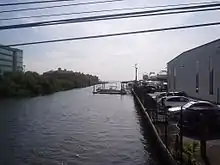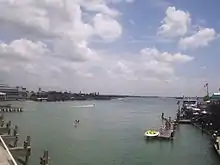1848 Tampa Bay hurricane
The 1848 Tampa Bay hurricane, also known as the Great Gale of 1848, was the most severe hurricane to affect Tampa Bay in the U.S. state of Florida and one of only two major hurricanes to make landfall in the area, the other having occurred in 1921. It affected the Tampa Bay Area September 23–25, 1848, and crossed the peninsula to cause damage on the east coast on or about September 26. It reshaped parts of the coast and destroyed much of what few human works and habitation were then in the Tampa Bay Area. Although available records of its wind speed are unavailable, its barometric pressure and storm surge were consistent with at least a Category 4 hurricane.[1][2][3] A survivor called the storm "the granddaddy of all hurricanes."[4]
| Category 4 major hurricane (SSHWS/NWS) | |
| Formed | September 23, 1848 |
|---|---|
| Dissipated | September 28, 1848 |
| Highest winds | 1-minute sustained: 130 mph (215 km/h) |
| Lowest pressure | 948 mbar (hPa); 27.99 inHg |
| Fatalities | 0 |
| Damage | $20,000 (1848 USD) |
| Areas affected | Central and North Florida |
| Part of the 1848 Atlantic hurricane season | |
Meteorological history
The storm appears to have formed in the central Gulf of Mexico before moving northeast to make landfall near Clearwater, Florida. It then crossed the Florida peninsula and exited near Cape Canaveral.[3] After moving into the extreme western Atlantic, the cyclone continued to the northeast just offshore of the East Coast of the United States to the Grand Banks of Newfoundland.[5]
Impact
Gulf of Mexico and Florida

Fort Brooke recorded peak winds of 72 miles per hour (116 km/h), and a barometer at the fort measured a minimum pressure of 28.18 inches of mercury (954 mb), though the winds were still blowing at the time that reading was made.[6] The storm produced the highest storm tide ever experienced in Tampa Bay.[7] The water rose and fell about 15 feet (4.6 m) in six to eight hours. The tide inundated Pinellas County "at the waist,"[8] covering all low-lying elevations,[9] and reportedly submerged most of the Interbay Peninsula, where South Tampa and MacDill Air Force Base currently reside.[10] "The bays [Hillsborough and Old Tampa] met."[8] General R. D. A. Wade, commanding at Fort Brooke, reported the destruction of the wharves, public buildings, and storehouses.[8] B. P. Curry, the fort's assistant surgeon, reported the hospital destroyed. Only five houses were left standing in Tampa, and they were all damaged.[8] The water rose twelve feet higher than had been noted in the past, and strong winds downed many old trees.[11] On the Pinellas Peninsula, the storm destroyed the fishing rancho of Antonio Máximo Hernández, reputedly lower Pinellas' first white settler, forcing him to emigrate permanently.[12] The storm almost obliterated the citrus crop and destroyed the main house at St. Helena plantation—now part of Safety Harbor—forcing the residents to shelter on an elevated Tocobaga midden. Even so, they nearly drowned as the storm tide eroded part of the shell mound.[12] Winds also felled almost all of the trees along what is now Indian Rocks Road in Largo.[13]

The storm completely altered the coastal geography of the Tampa Bay area, cutting new inlets, filling in others, and altering the shape of bays and keys, thereby making navigational charts useless to mariners.[11][14] Allen's Creek was widened from less than 200 feet (61.0 m) to about half a mile at its mouth. Passage Key, between Egmont Key and Anna Maria, was obliterated but reformed later. The storm created what would become known as "Soldier's Hole" at Mullet Key, so called because soldiers at Fort De Soto used it as a swimming hole. John's Pass was opened but has since shifted north. After the storm destroyed the lighthouse on Egmont Key, the keeper (Marvel Edwards) rode out the storm in a rowboat tied to a palmetto tree. The end of the rope was later found 9 ft (2.74 m) off the ground, which had an elevation of about 6 ft (1.83 m).
At Englewood, Stump Pass was cut. Casey's Pass was opened at Venice. New Pass was opened between Sarasota Bay and the Gulf, splitting Palm Island into Longboat and Lido Keys.[15] Farther south, the storm significantly damaged the Charlotte Harbor area near present-day Fort Myers.[6] Elsewhere, ships also encountered the storm. A brig, sighted in the Gulf of Mexico near Cedar Key, encountered the storm while at most 80 miles (129 km) from St. Marks, Florida; the ship lost its mast to the storm.[6]

Damage on the east coast may have been less severe, but the storm still produced significant effects and was described in the Savannah Republican as, "blowing 'great guns' – the hardest blow felt [on the St. Johns River] for several years." It blew down houses in Jacksonville and caused flooding in St. Augustine, as well as interference with shipping on the St. Johns River.[16]
See also
- 1840–49 Atlantic hurricane seasons
- Saffir–Simpson hurricane wind scale
References
- Edward N. Rappaport; Jose Fernandez-Partagas; Jack Beven (1997). "The Deadliest Atlantic Tropical Cyclones, 1492–1996: Cyclones that may have caused 25+ deaths". NOAA. Retrieved 2007-01-02.
- Al Sandrik; Chris Landsea (2003). "Chronological Listing of Tropical Cyclones affecting North Florida and Coastal Georgia 1565–1899". Hurricane Research Division. Retrieved 2007-01-02.
- Brian H. Bossak. Early 19th Century U. S. Hurricanes: A GIS Tool and Climate Analysis. Retrieved on 2006-08-01.
- Grismer 1946, p. 35
- Michael Chenoweth. A Reassessment of Historical Atlantic Tropical Cyclone Activity: 1700–1855. Retrieved on 2007-02-18.
- Ludlum 1963, p. 154
- Arsenault 1996, p. 32
- Pizzo 1968, p. 19
- Arsenault 1996, pp. 32–3
- Barnes 1998, p. 61
- Barnes 1998, p. 62
- Arsenault 1996, p. 33
- Largo Area Historical Society 1976, p. 148
- Arsenault 1996, pp. 33, 35
- Sarasota County History Center. Historic Sarasota County: 1841–1910. Archived 2006-10-08 at the Wayback Machine Retrieved on 2007-02-18.
- Al Sandrik and Christopher Landsea. Chronological Listing of Tropical Cyclones affecting North Florida and Coastal Georgia 1565–1899. Retrieved on 2006-08-01.
Bibliography
- Arsenault, Raymond (1996), St. Petersburg and the Florida Dream, 1888–1950, Gainesville, Florida: University Press of Florida, ISBN 0-8130-1667-3
- Fuller, Walter P. (1972), St. Petersburg and Its People, St. Petersburg, Florida: Great Outdoors Publishing, ISBN 978-0820010236
- Grismer, Karl (1946), The Story of Sarasota, The Florida Grower Press
- Barnes, Jay (1998), Florida's Hurricane History, Chapel Hill, North Carolina: Chapel Hill Press, ISBN 0-8078-2443-7
- Largo Area Historical Society (1976), Largo...Then 'Til, Apopka, Florida: Midnight Books
- Ludlum, David M. (1963), Early American Hurricanes, 1492–1870, Boston: American Meteorological Society, ISBN 0-933876-16-5
- Pizzo, Anthony P. (1968), Tampa Town, 1824–1886: the Cracker Village with a Latin Accent, Miami: Hurricane House, ASIN B0007E4B5O
- Google Earth. July 27, 2006.